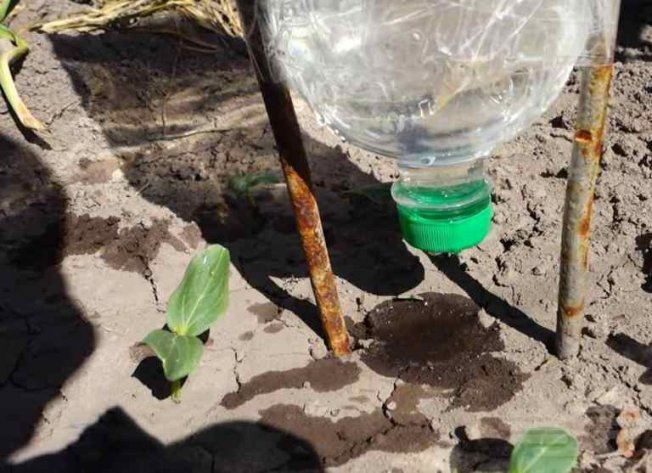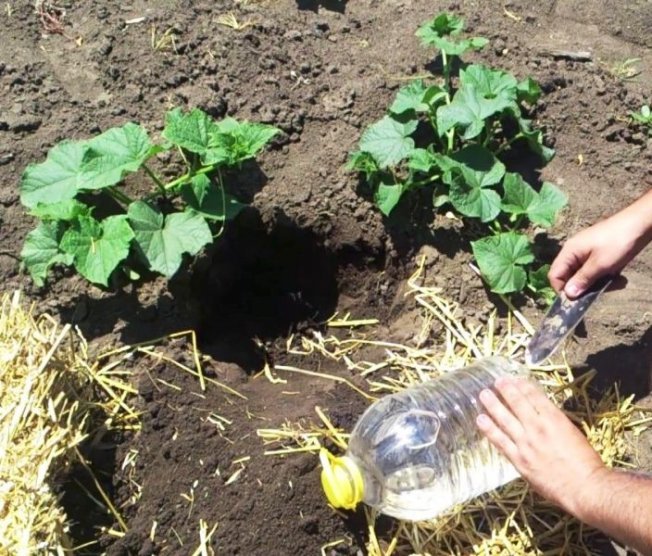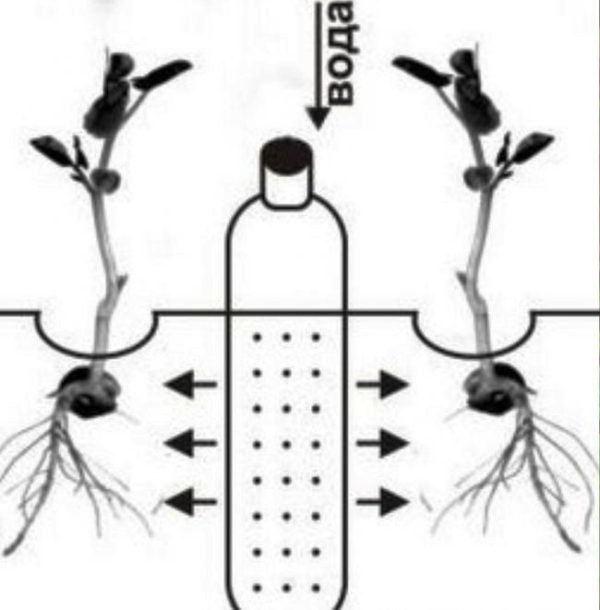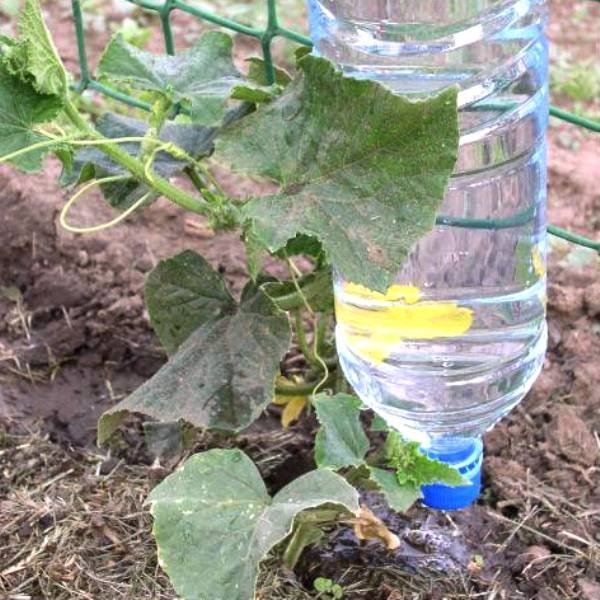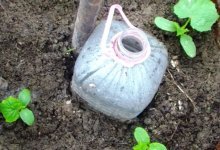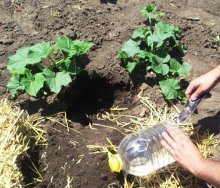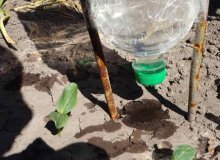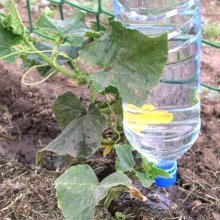Watering cucumbers through plastic bottles in a greenhouse and in open ground, photos and videos
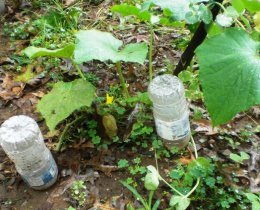
Summer residents who cannot permanently live in a suburban area have to invent different options for using available means to systematically provide plants with water. Take, for example, watering cucumbers through plastic bottles: organizing this option will not require financial costs, and will bring considerable benefits.
Content:
- What are the advantages of using plastic bottles
- Are there any disadvantages
- What types of plastic irrigation are used?
- Secrets of watering cucumbers from experienced vegetable growers
What are the advantages of using plastic bottles
Watering cucumbers through plastic bottles is a good low-budget option organization of drip irrigation in a greenhouse or open ground, especially if the summer is dry and it is not possible to visit the garden every day.
Let's take a closer look at the benefits of drip irrigation from bottles:
- availability of materials;
- you can assemble the system yourself;
- saving money and time, filling containers with water is not a difficult task;
- the ability to leave the garden unattended for several days and not be afraid that the cucumber beds will dry out;
- moisture is supplied to the root system slowly and evenly, without washing out the roots;
- With such watering, the surface of the earth is not moistened, weed seeds germinate slowly, and the soil is not compacted. If mulching of beds is used, then there is no need to loosen them;
- in greenhouse conditions, the evaporation of moisture from the soil is minimal, the chance of avoiding the development of fungal diseases increases significantly;
- In the absence of a centralized water supply in the area, bottle watering allows for considerable water savings. But when using water from a tap, if a meter is installed in the house, there will not be any significant savings;
- watering will always be done with heated water, which is very important for cucumbers;
- The bottle watering system is very easy to install; replacing damaged containers takes little time;
- It is possible to regulate the volume of water introduced; this will require making additional holes.
Are there any disadvantages
Option watering cucumbers through plastic bottles still has some disadvantages:
- it is impractical to organize such an irrigation system over a large area;
- plastic watering can most likely be considered temporary; it is not recommended to abandon high-quality watering with large quantities of water;
- the use of such irrigation may be difficult on heavy clay soils; the holes in the containers will often become clogged.
What types of plastic irrigation are used?
Watering cucumbers through plastic bottles in open ground or in greenhouses is far from identical concepts. Therefore, you should choose a suitable method of adding moisture taking into account the requirements for the growing conditions of the vegetable crop.
To choose an option, you should be thoroughly familiar with the types of plastic irrigation; it may involve:
- digging in bottles;
- installing containers near plants;
- securing flasks to suspended structures;
- the use of devices that allow dosed water supply.
Let us consider in detail several options for organizing an irrigation system.
Method I
It is fashionable to use for greenhouses and open ground. We prepare the bottle: we pierce holes at a height of 3-4 cm from the bottom; this is convenient to do with a heated awl or a thick needle.
You will need to determine the number of holes yourself; the denser the soil on the site, the more holes will be required. The prepared bottle is dug into the ground among the honey bushes to a shallow depth.
Water is poured into the bottle. If a lid is used, a hole should be made in it to allow air to enter. But it is not necessary to close the flasks.
If the soil is excessively moist, the bottle will have to be replaced with another one, with fewer holes, but if it is too dry, more holes will have to be made.
Let's watch an interesting video about watering cucumbers through plastic bottles:
Method II
It differs from I in that holes are made near the neck of the bottle, and the bottom is cut off. After tightening the cork, the bottle is dug in directly next to the bush, neck down. Next, water is poured into it. The irrigation system is ready. To prevent active evaporation of moisture, it is recommended to cover the cut bottom of the flask, perhaps with the same bottom, but upside down.
If the soil is very dense, then you don’t have to make holes; it will be enough to tightly close the neck with a piece of foam rubber, but for sandy soil this option is not suitable, the water will run away instantly.
Method III
Owners who cannot appear at the dacha more than once a week can use the option of watering from a 5 or 10 liter container. Holes in such a container are pierced along one side, in a checkerboard pattern, in several rows along its entire height. A hole is cut on the opposite side of such a size that it is convenient to fill in water.
The flask is deepened into the ground between the bushes, lying down, the small holes should be at the bottom. Due to the larger capacity of the container, the period of automatic watering will extend for several days.
Method IV
Watering cucumbers in a greenhouse through plastic bottles can be organized in the following way:
- construct structures on which flasks of water will be placed, directly above the cucumber bushes;
- small holes are made near the neck, but you can simply screw the lid loosely, the water should slowly drip out;
- filled containers are hung;
- The dripping water should land near the cucumber stem.
The advantage of the method is that water does not erode the soil near the roots. The difficulty lies in the need to install supports. You also need to make sure that drops of water do not fall on the leaves - in sunny weather this can cause burns. This situation can be avoided by hanging containers at a low height above the ground.
In the same way, you can ensure watering of cucumbers through plastic bottles, provided that the plants are grown in a barrel.
Secrets of watering cucumbers from experienced vegetable growers
To moisten the soil, you can use ordinary plastic 2-liter containers, or 5-10 liter containers if you want to extend the life of the irrigation system to a week.
The holes should be made very small, from 1 to 1.5 mm, so that the water does not drain away too quickly.
To prevent soil from getting into the flasks, you can wrap them in old bags, non-woven fabric or just nylon stockings.
When calculating the number of containers for watering one bush, you should consider:
air temperature;
how often can you visit the garden;
density and composition of the soil.
It should also be taken into account that during the growth period one cucumber bush will require from 3 to 4 liters of water per week, during the flowering period and the formation of ovaries - up to 6-7 liters.
If the air temperature is too high, it is better to apply water to fruit-bearing plants once every three days, the recommended volume for a week is 1 liter.
During the rainy season, the volume of irrigation is reduced.
Since moisture evaporation occurs more actively under greenhouse conditions, more water is required for irrigation.
It is recommended to install the flasks immediately after sowing the seeds, while there is no threat of damage to the roots. Containers with liquid are placed at a distance of 15 cm from the bush, buried to a depth of 10 to 15 cm. There is no point in burying the bottles deeper; the roots of the cucumbers are located near the surface of the soil.
Let's watch a video with useful tips for organizing plastic drip irrigation:
Watering cucumbers through plastic bottles is a good idea to make the work of amateur vegetable growers easier; the drip version of soil moistening can be used in beds and greenhouses

